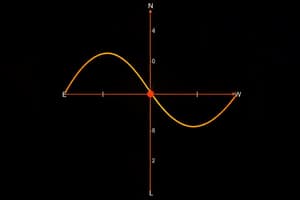Podcast
Questions and Answers
What does Cayley's Theorem state?
What does Cayley's Theorem state?
Every group is isomorphic to a group of permutations.
What does the Division Algorithm guarantee for integers m and n?
What does the Division Algorithm guarantee for integers m and n?
There exists unique q and r such that n=qm+r and 0 ≤ r < m.
What is stated in Corollary 8.4 regarding homomorphisms?
What is stated in Corollary 8.4 regarding homomorphisms?
If h:G->G' is a homomorphism and g in G, then h(g^n)=[h(g)]^n for all n in Z.
What are the two properties of a homomorphism as described in Lemma 8.5?
What are the two properties of a homomorphism as described in Lemma 8.5?
What does Theorem 9.1 indicate about elements in Sn?
What does Theorem 9.1 indicate about elements in Sn?
What is the significance of Corollary 9.2?
What is the significance of Corollary 9.2?
What does Theorem 10.1 state about cosets and groups?
What does Theorem 10.1 state about cosets and groups?
What does Corollary 10.3 imply about groups of prime order?
What does Corollary 10.3 imply about groups of prime order?
What does Theorem 11.1 state regarding the orders of elements in groups?
What does Theorem 11.1 state regarding the orders of elements in groups?
What condition must be met for GxH to be cyclic according to Theorem 11.3?
What condition must be met for GxH to be cyclic according to Theorem 11.3?
Study Notes
Cayley's Theorem
- Every group G can be represented as a group of permutations of itself.
- Defined a map τ_g: G -> G by τ_g(x) = gx; it's a bijection.
- If τ_g(x) = τ_g(y), then by cancellation, x = y (injectivity).
- The map is onto since τ_g(hg^-1) = h for any h in G.
- A homomorphism φ: G -> S_G is established where φ(g) = τ_g.
- Shows that φ(gg^hat) = φ(g)φ(g^hat) indicating it's well-defined.
- If φ(g) = φ(g^hat), by injectivity, g = g^hat, confirming isomorphism.
Division Algorithm
- For any integers m > 0 and n, there exist unique integers q and r such that n = qm + r and 0 ≤ r < m.
Corollary 8.4
- If h: G -> G' is a homomorphism and g in G, then h(g^n) = [h(g)]^n holds for all integers n.
Lemma 8.5
- For a homomorphism h: G -> G' and subgroup H of G:
- h(H) is also a subgroup of G'.
- If h is injective, then H is isomorphic to h(H).
Theorem 9.1
- Every permutation σ in symmetric group S_n can be expressed as a product of disjoint cycles.
Corollary 9.2
- Any permutation in S_n, where n ≥ 2, can be expressed as a product of transpositions.
Theorem 9.3
- If σ is expressible in two different ways using transpositions, both expressions share the same cycle pairing.
Theorem 10.1
- For a group G and a subgroup H:
- Left cosets of H within G partition G.
- Right cosets of H within G also partition G.
Corollary 10.3
- If a group's order |G| is prime, then G is cyclic.
Corollary 10.4
- In a finite group G, the order of any element g in G divides the order of G.
Theorem 10.5
- For subgroups K and H of G:
- If the indices [G:H] and [H:K] are finite, then [G:K] = [G:H][H:K].
Theorem 11.1
- For groups G and H with elements g in G and h in H of finite order, the order of the pair (g, h) is the least common multiple of their individual orders, |(g,h)| = lcm(|g|, |h|).
Corollary 11.2
- For groups G1,...,Gn where each gi has finite order, the collective order is given by |(g1,...,gn)| = lcm(|g1|,...,|gn|).
Theorem 11.3
- The direct product G x H of finite cyclic groups is cyclic if and only if the orders |G| and |H| are relatively prime.
Corollary 11.4
- The direct product of finite cyclic groups ∏_(i=1)^n G_i is cyclic if and only if the orders |G_i| and |G_j| are relatively prime for all i ≠ j.
Studying That Suits You
Use AI to generate personalized quizzes and flashcards to suit your learning preferences.
Description
Explore key concepts in abstract algebra with these flashcards focusing on theorems, corollaries, lemmas, and their proofs. This resource is designed to help you understand the fundamental structures of groups, including Cayley’s Theorem and its implications. Perfect for students preparing for exams or wanting to solidify their knowledge in abstract algebra.




